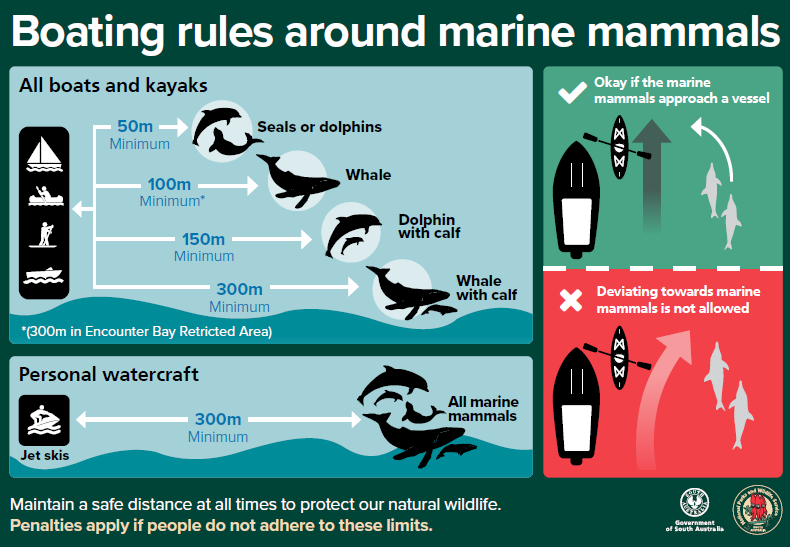Whales and dolphins
All marine mammals including whales, seals, sea lions and dolphins, are protected in South Australian waters and any person causing harm to a marine mammal can expect a heavy fine.
National Parks and Wildlife legislation specifies minimum allowable distances from whales and dolphins for various types of boats and other water users.
Some further restrictions may apply within the Adelaide Dolphin Sanctuary, located mainly within the Port Adelaide River. You must reduce speed and change direction away from whales and dolphins to protect them and ensure your safety.

What do I do if I encounter a whale or dolphin while boating
If you encounter whales or dolphins when on the water it can be tempting to go up close for a look. Approaching too close to whales and dolphins is illegal due to safety concerns for the animals. It can also be dangerous as a whale, particularly a female with a young calf, can feel threatened and react unexpectedly.
Keep well clear during mating time, generally during the winter months, as whales get quite boisterous.
Keep your boat well away from any whales and avoid:
- travelling on a collision course, especially head-on toward a whale or dolphin
- sudden changes of speed or direction.
Specific rules apply to the operation of personal watercraft, such as jet skis and wave-runners near dolphins because their speed and manoeuvrability can pose greater risks to whales and dolphins.
Aquatic reserves and marine parks
Aquatic reserves and marine parks safeguard important marine habitats, species of flora and fauna, significant natural features and cultural heritage.
Restrictions in aquatic reserves range from totally closed areas to areas allowing some recreational fishing. These are sometimes signposted. Please check for details before you go boating.
Marine park sanctuary zones prohibit all forms of extractive activities, including fishing and collecting, mining, aquaculture and dredging. Maps and coordinates are available online at www.marineparks.sa.gov.au
Sanctuary zone boundaries are progressively being incorporated into navigational charts and other publications.
If you see a fishing offence in an aquatic reserve or marine park sanctuary zone, please contact FISHWATCH on 1800 065 522
If you use a chart of the area and a hand-held GPS receiver for navigation, you should take care. Variances can occur both from GPS inaccuracy and from changing conditions since the chart was printed.
Laws
Both state and federal laws protect whales and dolphins, including the distances that boats, swimmers and aircraft may approach. The relevant state legislation, administered by the Department of Environment and Water, is the National Parks and Wildlife Act 1972 and the National Parks and Wildlife (Protected Animals - Marine Mammals) Regulation 2010.
Within the Encounter Bay Marine Park all vessels and persons must keep a distance of 300 meters from any marine mammal. Further information can be found at the National Parks and Wildlife Service.
Speed limits are in place for parts of the Adelaide Dolphin Sanctuary for the protection of all water users and marine life. Limits of four knots and seven knots are signed throughout the area.
Reporting unsafe vessel operating near marine mammals
Members of the public can report vessels operating unsafely or harassing marine mammals via the report a marine safety concern online tool.
Please provide as much detail as possible including vessel registration details, nature of the incident, identity or description of people involved (if any). Please provide photo / video evidence if available.
Sightings of sharks
If you see a shark near swimmers or where it could otherwise harm humans, please report the location, description, distance to shore, and your contact details to one of the following:
- FISHWATCH, telephone: 1800 065 522
- SA Police, telephone: 131 444
- The local surf lifesaving club.
Sightings of rare species
If you see marine life that’s unusual in South Australian waters, including turtles, strange fish and sea snakes, please contact the South Australian Museum.


